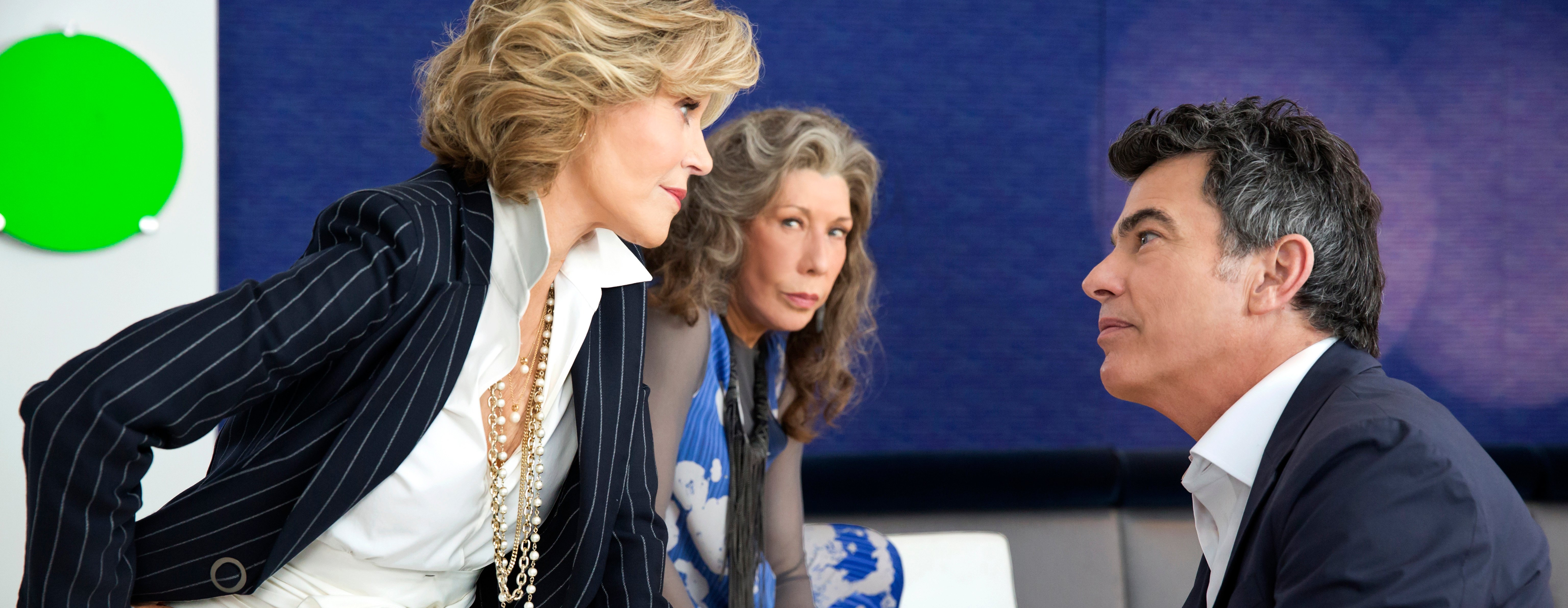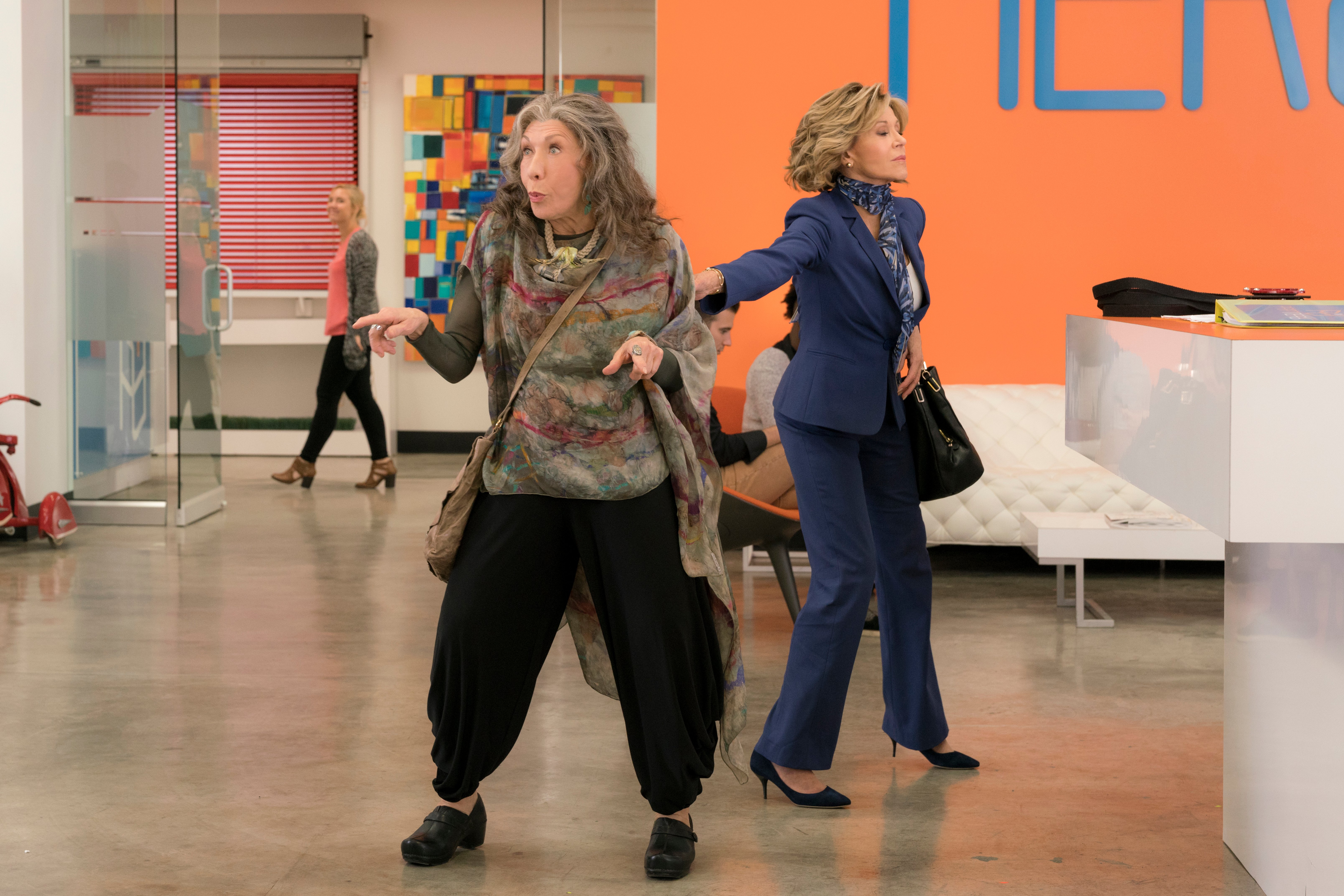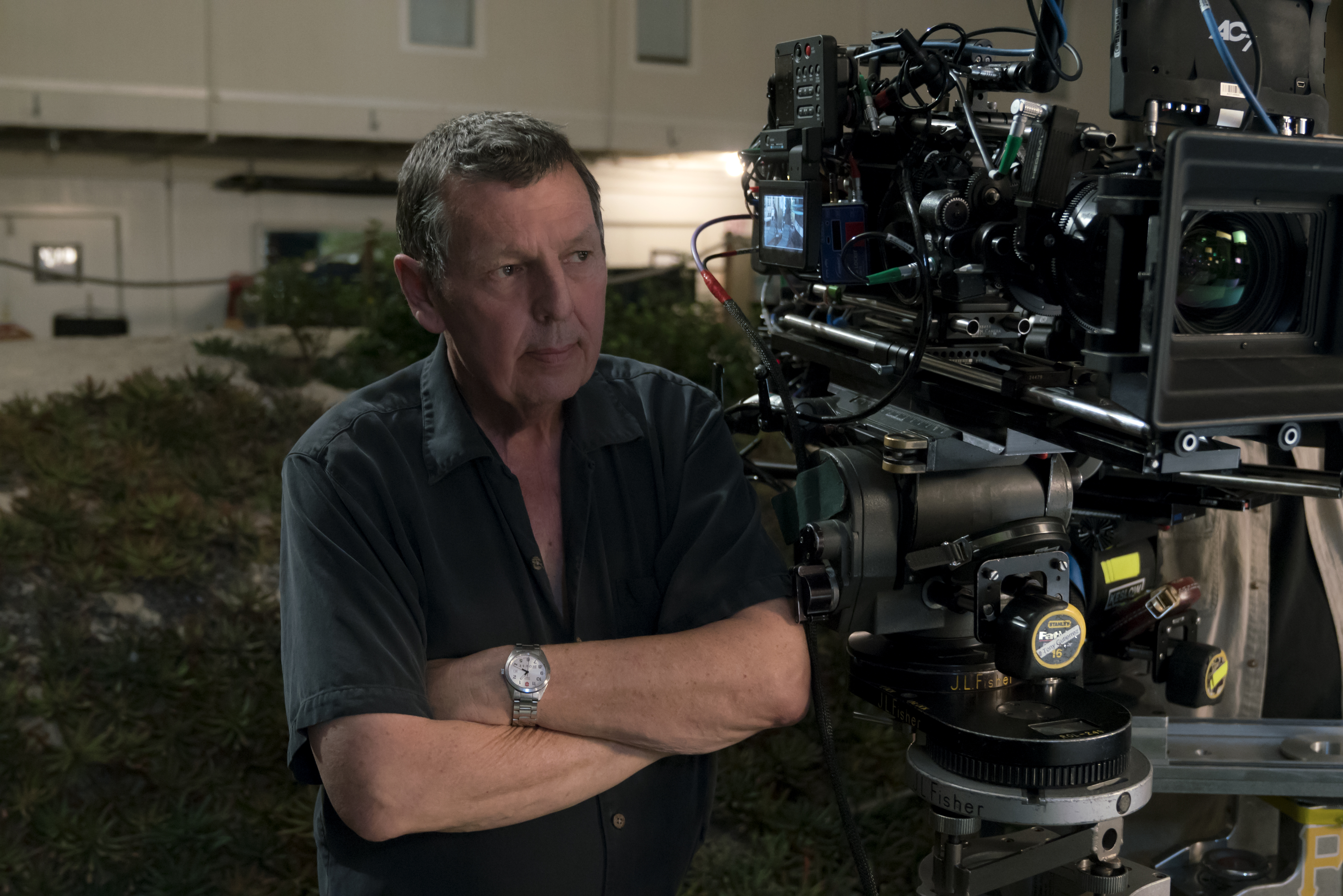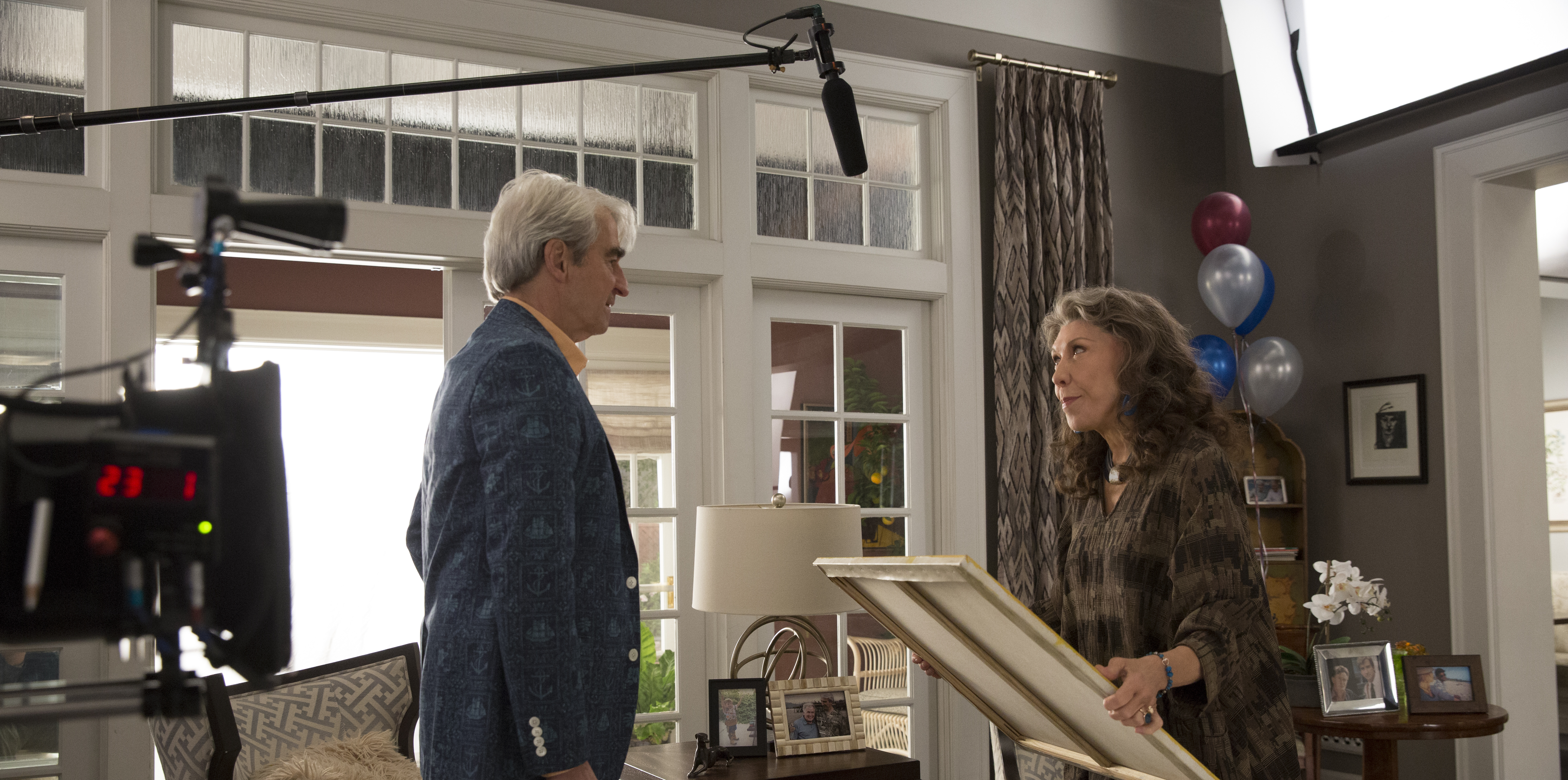
Living Situation: Grace and Frankie
Director of Photography Gale Tattersall details his “soft sources” approach to this comedic Netflix series.
The Netflix series Grace and Frankie stars Jane Fonda as disciplined, imperious businesswoman Grace, and Lily Tomlin as free-spirited Frankie. Polar opposites, the two are forced to live under the same roof after their husbands of 40 years (played by Martin Sheen and Sam Waterston) announce that they are gay, have been deeply in love with one another for years, and — now that same-gender marriage is legal in California — plan to divorce their wives and marry each other. The show’s third season streamed in late March, and season four is currently in production.
When director of photography Gale Tattersall was hired to shoot season one, he knew what his first task would be. Netflix mandates shooting 4K, but he felt that none of the 4K digital cameras available in 2014 — a mere three years ago, but practically the Mesozoic Era in technological terms — was suitable for showcasing the iconic actresses around whom the half-hour episodic comedy series was specifically built.

“It is in everybody’s interest to make Jane, Lily, Sam and Martin look wonderful — and of course the rest of the cast — but 4K cameras back then were probably the worst choice because they produced images [so crisp that] they were almost medically analytic,” says Tattersall during a conversation with AC at Paramount Studios. “High resolution and contrast are the last things you want when shooting actors of such distinguished stature. What you want is the forgiveness of film.”
Accompanied by gaffer Luke Miller and 1st AC Tony Gutierrez, the British-born cinematographer — known for his work on House, From the Earth to the Moon, Ghost Ship and The Commitments — discussed how he and his crew create the soft, cinematic look the show demands.
For the first two seasons, Tattersall used the Red Epic Dragon, relying on French silk stockings as rear lens netting, and an innovative lighting concept he and Miller developed to obtain the aesthetic they desired. For season three, they switched to Canon’s Cinema EOS C300 Mark II.
Canon had introduced the camera in the fall of 2015 and Tattersall fell in love with it. The new Super 35mm CMOS sensor produced a filmic look without the need for filtration, while its dynamic range of 15 stops provided plenty of opportunities in post.
When capturing with either the Red or the Canon, 90 percent of the show has employed 17-80mm (T2.2) and 24-290mm (T2.8) Angenieux Optimo zooms. A Steadicam is pressed into service a few times per episode — more frequently when the production goes on location — and it is usually paired with one of two Angenieux lightweight zooms: a 15-40mm or a 28-76mm (both T2.6).
“Our primary light is almost all indirect. Because the sources are large and soft and as far back as possible — which isn’t all that far, given that the sets are built right up to the fire lanes.”

Four cameras are always on hand: the A and B, which are normally on dollies; a third one that remains on Steadicam; and a fourth body — the only one with an EF mount rather than a PL mount — that Gutierrez stripped down to its bare bones so it could fit into unusual spots, such as the inside of a refrigerator. The latter camera, christened the “Ninjacam,” “is usually fitted with a Canon still lens and is often used on a bazooka,” he notes. “The Canon still-lens catalogue is huge, so Gale has a lot of different lenses at his disposal.” Gutierrez reports that the production carries several Canon EF lenses specifically for use on the Ninjacam, including “a 15.5-47mm and a 30-105mm [Cinema Compact Zoom, both T2.8], plus a hodgepodge of Canon primes. Whenever we needed a specialty shot or employed Ninjacam for extra footage, it used the Canon EF lenses.”
“We must put in a ‘hurrah’ for Keslow Camera,” Tattersall interjects. “They are the most awesome rental house. They have a machine shop and make special parts for us. From CEO-owner Robert Keslow and chief operating officer Dennis McDonald on down, they are just terrific.”
The production’s lighting package is provided by Paramount, and the watchword on Grace and Frankie is “soft sources.” Tattersall says, “Luke and I designed a plan that, in a sense, turns every shot into a photographic studio. We put Jane and Lily inside the light by [surrounding them] with light. Jane once asked me where the key light was. Well, a lot of the time there isn’t one — or, rather, the whole thing is a key light.”
Open-faced traditional tungsten units — “1K Redheads and 2K Blondes,” Miller specifies — serve as the main interior light sources. Hung at angles from above, they are bounced into large pieces of bleached muslin that cover virtually every inch of wall that isn’t in the shot. “Key grip Jerry Deats came up with the idea of hanging rolls of muslin that could be rolled up or down the wall, depending upon our needs,” says Miller. “Pull two down next to one another and suddenly you have a 12-foot-wide soft source.
“Our primary light is almost all indirect,” he continues. “Because the sources are large and soft and as far back as possible — which isn’t all that far, given that the sets are built right up to the fire lanes — characters can walk from the living-room sofa to the dining-room table without going in and out of a key light. We try to avoid shooting opposing angles because that can compromise the lighting. We usually have a few floor units that we move around per shot.”
Finally, nine-light fays are positioned a few feet behind 12'x12' diffusion rags, to create a large soft source. “The units are very shallow, work well in confined spaces, and spread the light really well,” explains Tattersall. “They are directional, rather than bounced, but go through diffusion — Light Grid, Quarter Grid, and sometimes double-diffused with an additional Opal or 250 to soften things even more.”

Grace and Frankie live in an elegant beach house ostensibly in La Jolla, Calif., for which the practical exterior and surrounding neighborhood are actually shot in Malibu, while interiors are shot on the Paramount lot, where three stages are reserved for the show. The beach house is quite open, with many windows, and double glass doors leading out to a back patio, which is also a set, and the ocean beyond. Originally, a Rosco backing provided the view of the ocean; these days, however, the ocean is added entirely in post with the aid of bluescreen. Bigger tungsten units — including 10Ks and 20Ks — push light into the house through windows. “If we aren’t looking directly out toward the water, we usually put big diffusers on the patio — Light Grid 12-bys — and blow even more light in,” Tattersall notes.
Asked to describe the look of Grace and Frankie, the cinematographer replies, “It’s easy on the eye — Jane’s quote — and looks very natural. The lighting is not making a statement.” And as to camera angles on the production, he remarks, “Comedy is about action and reaction; somebody says something and the other person reacts. Singles don’t work that well in comedies; two-shots are much more common. We tend towards wider over-the-shoulder shots rather than close-ups. Similarly, wide shots don’t have an awful lot of value in comedies. The viewer isn’t really interested in the architecture; they want to see Jane and Lily.”
Miller recalls the episode in which both Grace and Frankie throw out their backs and are crawling around on the floor, writhing in pain. The scene required shots that were low and moving. “Jerry made a rig with a piece of carpet on the bottom of the cheese plate, so it would slide on the woodwork like a dust mop. It had a long pole with a camera mounted on the bottom — it actually looked like a mop — and you just rested it on the ground and pulled it. It enabled us to get wonderful shots of Jane’s and Lily’s faces as they crawled on their stomachs.”
“Even though Grace and Frankie has a half-hour format, in terms of lighting it has a single-camera look, as opposed to [the look of] a live three-camera show,” Gutierrez adds. “I consider our way of shooting to be a throwback to how shows used to be made: we do rehearsals, lay marks, then send the first team away. Gale does his lighting, we rehearse with the second team, the actors come back, rehearse again [until] everybody feels comfortable, and then we shoot.”
The production, which is framed for a 1.78:1 aspect ratio, averages 40-50 setups a day. The C300 Mark II captures in Canon Log 2, and the cameras record internally to CFast cards.
The fact that Canon’s C300 Mark II can shoot at a much higher ISO without introducing grain has been a huge plus on many fronts, including the ability to use less-powerful lighting fixtures at night. “The two extra stops we get when we go to 3,200 ISO is just awesome,” Tattersall enthuses, “although we have found that our optimum situation is 400 ISO; we discovered there is a tiny reduction in noise compared to shooting at 800 ISO.” Most of the show is shot between T2.8 and T4.5.
“Until season three, we didn’t have a color-correcting monitor at video village,” the cameraman acknowledges. “All we were able to see there was Rec 709 and there was a lot of concern among producers and directors, who urged us to light to the monitors. All we could do to correct what they saw on the monitor was to turn down the brightness. Thanks to Canon, we now have a fantastic Canon 4K monitor and an [on-set color-correcting methodology] for the A camera.” The B-monitor remains Rec 709.
“Our wonderful [final-grade] color timer over at Technicolor is Roy Vasich,” Tattersall says. Vasich performed the final grade at Technicolor with Blackmagic Design DaVinci Resolve at 4096x2160 (4K) resolution.
Tattersall notes with admiration that “showrunner Marta Kauffman has a fantastic eye for style, which art direction, set dressing and wardrobe bring to life. Marta and Howard J. Morris created the series and write the season opener and season finale. And then there is my extraordinary crew, which works seamlessly together. I worked with my remarkable A-camera operator Chris Murphy on House, Randy Nolen is B-camera and Steadicam operator, and Deats is key grip. And then, of course, there’s Luke and Tony. It is rare that one is lucky enough to work with such iconic actors, but we are blessed by having created a wonderful family of talented people. Our producer Randall Winston and unit production manager Joan Van Horn go all the way to help us make the best show that we can, and our other main producers, Robbie Tollin and Hannah K.S. Canter, inspire us to do our best work.”
Tattersall is an avid champion of Canon and is looking forward to trying out the company’s new Cinema EOS C700 at some point on season four. “I think this is a really defining moment for Canon,” he says. “With the C300 Mark II — and now the C700 — this really is the company’s coming-of-age in Hollywood.”
TECHNICAL SPECS
Aspect Ratio: 1.78:1
Digital Capture
Canon C300 Mark II
Angenieux Optimo; Canon Cinema Compact Zoom






